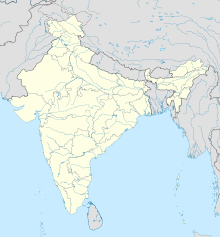|
Kenda Area
Kenda Area is one of the 14 operational areas of Eastern Coalfields Limited located mostly in Durgapur subdivision and partly in Asansol subdivision of Paschim Bardhaman district in the state of West Bengal, India. Geography
3km 2miles
ECL Chhora Hospital S
ECL Kenda Area Office A
Haripur Colliery U
CL Jambad Colliery U
Bahula Colliery U
New Kenda Colliery U
Chhora Block Incline U
Siduli Colliery U Collieries in the Kenda Area of Eastern Coalfields U: Underground Colliery, O: Open Cast Colliery, S: Mining support, A: Administrative headquarters Owing to space constraints in the small map, the actual locations in a larger map may vary slightly LocationThe Kenda Area is located around 23°40′02″N 87°10′45″E / 23.6673°N 87.1793°E The Kenda Area is bounded by the rural areas of Jamuria and Pandabeswar CD Blocks on the north, Sonpur Bazari and Bankola Area on the east, Kajora Area on the south, and Kunustoria Area on the west.[1][2][circular reference] The map alongside shows some of the collieries in the Area. However, as the collieries do not have individual pages, there are no links in the full screen map. CoalAs per the Shodhganga website, collieries in the Kenda Area are: New Kenda, Bahula, Lower Kenda, Haripur, Chora, Chora Incline, Siduli, C.I. Jambad and Chora OCP .[3] As per ECL website telephone numbers, operational collieries in the Kenda Area in 2018 are: Bahula Colliery, Chora Block Incline, CI Jambad Colliery, Chora OCP, Haripur Colliery, Lower Kenda Colliery, New Kenda Colliery, Siduli Colliery, SK OCP, West Kenda OCP.[4]  Mining planAn overview of the proposed mining activity plan in Cluster 11 of 11 mines in Kenda Area (including some mines in adjoining areas), as of 2016, is as follows:[5][6] 
5km 3miles
Damodar River
Ajay River
Madhaipur R
Shyamsundarpur R
Tilaboni R
Pandabeswar R
Laudoha R
Durgapur MC
ECL Sonpur Bazari Area Office
ECL Jhanjhra Area Office
ECL Bankola Area Office
ECL Pandaveswar Area Office
ECL Kenda Area Office
Parashkol CT
Chak Bankola CT
Bilpahari CT
Ramnagar CT
Dalurband CT
Baidyanathpur CT
Mahal CT
Konardihi CT
Nabgram CT
Sankarpur CT
Haripur CT
Chhora CT
Bahula CT
Mandarbani CT
Banagram CT
Sirsha CT
Nabaghanapur CT
Sarpi CT
Ichhapur CT
Kendra Khottamdi CT Cities, towns and ECL Areas in the northern portion of Durgapur subdivision in Paschim Bardhaman district MC: Municipal Corporation, CT: census town, R: rural administrative centre Owing to space constraints in the small map, the actual locations in a larger map may vary slightly Open-cast mine at KendaIn a study regarding the feasibility of an open cast mine at Kenda, it was mentioned that both R-V and R-VI seams had been extensively developed and underground mining carried out for many years. 13.6 million tonnes of good quality coal was lying blocked in the pillars. Open cast mining was recommended for taking out this coal, as well as coal from a virgin R-VIIB seam, which otherwise was difficult to mine because of low thickness of the seam. Once the coal from the upper seams is taken out, the quarry is to be backfilled and underground mining of the lower seams can be undertaken. The total area of the coal block is about 7 km2. About 300 acres of land was required for the project, a proposal in which land owners evinced interest in lieu of compensation including employment. The employment potential of the project was much higher than the number of landowners. In addition, the area could benefit from CSR-related activities. Water supply arrangements for Kenda mouza was already in progress.[7] As of 2018, West Kenda OCP is in operation around where the New Kenda Colliery is.[7][8] Fire in New Kenda Colliery in 1994"On 25.1.1994 at about 3.30 p.m. a fire broke out in the workings of Dobrana seam at New Kenda Colliery. The fire occurred in the main intake airway close to the downcast shaft. Smoke and noxious gases from the fire spread to the working places and caused the death of 55 persons. This has been the worst fire disaster of this century in Indian mines." The fire could not be extinguished immediately and the fire area had to be sealed off. The fire died down after about one and a half years. After the fire died down, heavy roof fall was observed in the sealed off galleries.[9] SubsidenceTraditionally many underground collieries have left a void after taking out the coal. As a result, almost all areas are facing subsidence. As per CMPDIL, there were 9 points of subsidence in the Kenda Area involving 120.96 hectares of land.[10] MigrantsPrior to the advent of coal mining, the entire region was a low-productive rice crop area in what was once a part of the Jungle Mahals. The ownership of land had passed on from local adivasis to agricultural castes before mining started. However, the Santhals and the Bauris, referred to by the colonial administrators as "traditional coal cutters of Raniganj" remained attached to their lost land and left the mines for agricultural related work, which also was more remunerative. It forced the mine-owners to bring in outside labour, mostly from Bihar, Odisha and Uttar Pradesh. In time the migrants dominated the mining and industrial scenario. The pauperization and alienation of the adivasis have been major points of social concern.[11][12] Transport
The Andal-Sainthia branch line passes through this Area.[13] NH 14 (old number NH 60) pass through the edges of Kenda Area.[14] Notable peopleReferences
|
|||||||||||||||||||||||||||||||||||||||||||||||||||||||||||||||||||||||||||||||||||||||||||||||||||||||||||||||||||||||||||||||||||||||||||||||||||||||||||||||||||||||||||||||||||||||||||||||||||||||||||||||||||||||||||||||||||||||||||||||||||||||||||||||||||||||||||||||||||||||||||||||||||||||||||||||||||||||||||||||||||||||||||||||||||||||||||||||||||||||||||||||||||||||||||||||||

